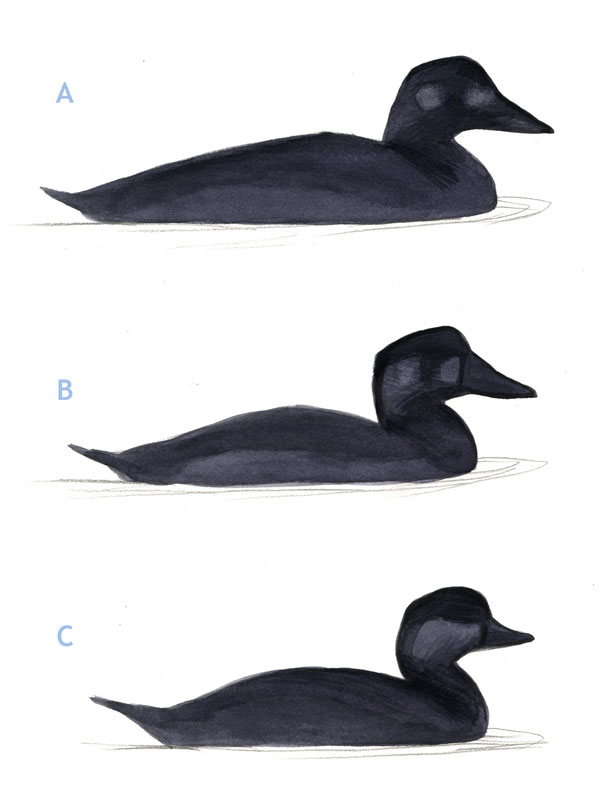I was recently studying and sketching the three species of American scoters in Revere, Massachusetts, and I was struck by the differences in head and body shapes. I thought those differences deserved to be highlighted in some new sketches, which are shown below. If you enjoy quizzes, you can try to identify the three species, or just go straight to the discussion below.

The three North American scoters can be distinguished readily by details of the head and bill, but like many birds of open water they are often seen at a great distance in bad light, when details such as bill shape and plumage patterns cannot be ascertained. More subtle (but equally diagnostic) differences in silhouette then become important.
A – White-winged Scoter
- bill relatively large but fine-tipped, with sloped or slightly “scooped” forehead
- head relatively small with crown angled down to inconspicuous corner on hind-crown, but much shorter distance to hind-peak than on Surf
- neck thicker at base
- back of neck angles down and back
- back relatively flat, highest near front and sloping gradually to tail
- tail relatively short and less often raised
B – Surf Scoter
- bill large and bulky, angled slightly down
- peak on forehead and long slope to very strong corner on hind-crown
- neck evenly thick
- back of neck more or less vertical
- back peaked in center, not as rounded as Black
- tail fairly long and sometimes raised, but less conspicuous than Black
C – Black Scoter
- bill small, slightly upturned and with strongly “scooped” forehead
- rounded crown with very slight corner on hind crown
- neck thinner than other two species
- back of neck curved
- back rounded, riding higher in water
- tail long and often conspicuously raised


Re id-ing scoters by shape; this is very helpful. One thing, you note that Black Scoter has a strongly “scooped” forehead. So I expected to see a hollowed out cavity. Instead there’s a bulge. Clearly, I’m not understanding the term. Could you clarify?
Many thanks,
John
Hi John, I see your point. The forehead does bulge more than the other scoters and it’s really the bill that is “scooped”. Combined with the steep forehead that makes a much stronger curve than the other two. I guess what I’m referring to is not the forehead but the whole head and bill profile.
Pingback: White-winged Scoter and Black Scoter - The Other Ocean Ducks - Taylor County Big Year 2019
Perfect. Very helpful image and post to help focus on the primary features one would see! It helped me feel certain of my id the other day.